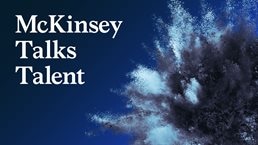Empathy: We all aspire to it, but does it really make a performance difference in the workplace? Definitely, according to Jamil Zaki, a research psychologist at Stanford University and author of The War for Kindness: Building Empathy in a Fractured World (Crown, June 2019). In this episode of McKinsey Talks Talent, Jamil joins McKinsey talent leaders Bryan Hancock and Brooke Weddle, with global editorial director Lucia Rahilly, to make the case for investing in empathic behavior—for reasons including higher productivity, a stronger workplace culture, and better organizational health—as well as to discuss how to go about cultivating kindness at work.
This conversation has been edited for clarity and length.
Why empathy matters at work
Lucia Rahilly: Let’s start with some context. Jamil, you’re a research psychologist. When you use the word “empathy,” what do you mean?
Jamil Zaki: Empathy isn’t actually one thing at all. It’s an umbrella term that describes at least three ways we connect with other people’s emotions. If you imagine the last time that you spent time with a friend who was upset, a few things might happen.
First, you might feel upset yourself, vicariously catching their emotions, which we would call emotional empathy or emotional contagion. You might also try to figure out what your friend is feeling and why, which we would call cognitive empathy.
And if you’re a good friend, you probably care about what they’re going through and might wish for them to feel better, which we would call empathic concern or compassion. These three pieces of empathy can split apart sometimes, and they have different uses in our lives and in our workplaces. But together, they make up the full range of human empathy.
Subscribe to the McKinsey Talks Talent podcast
Lucia Rahilly: And your book is called The War for Kindness. How is empathy related to kindness?
Jamil Zaki: Empathy is an experience. Kindness is a behavior. Kindness is the things we do for other people. There are lots of reasons you might act kindly. You might help your friend move because you owe them. Or you might help them because you care for them.
In the second case, it’s empathy that’s leading to kindness. And there are all sorts of evidence that when we are inspired to feel empathy, even for a moment, we help people—people in our lives or even strangers—by volunteering or donating to charity.
Lucia Rahilly: It’s fashionable to talk about empathetic leadership. But when we look around, we see a lot of examples of successful leaders who seem unlikely to do loving-kindness meditation on any regular cadence. And the louder buzzwords in the business world tend to be about concepts like innovation. Why does empathy really matter in the workplace?
Jamil Zaki: When I train leaders in empathy, one of the first hurdles I need to get over is this stereotype that empathy is too soft and squishy for the work environment. It’s easy to debunk that. There are decades of evidence showing that empathy is a workplace superpower.
Employees who believe their organizations, and especially their managers, are empathic tend to call in sick with stress-related illnesses less often. They report less burnout. They report better mental health and morale and a greater intent to stay at their organizations. People who feel empathized with also tend to innovate more and take creative risks.
In 2023, leaders were talking about a year of efficiency. It’s a mistake to assume that being efficient means tuning out emotionally and trying to disconnect from people so you can work them harder. But when people feel connected to their colleagues and to their leaders, they work harder, faster, and more creatively.
Bryan Hancock: What you’ve shared lines up with our research about managers. If managers are some of the people we want to be empathetic, how can we think about increasing their capacity for empathy?
Jamil Zaki: The first approach is managers spending more time connecting with people. That is so vital and often overlooked. In a quest for efficiency, we often ignore what allows us to be efficient at a deeper level.
We think, “I don’t have the time to sit with my employee and ask them how their life is going. I don’t want to turn work into a therapy session.” And that’s fine. But it might be the most efficient use of your time because if people feel connected, then they work more efficiently.
Once we establish that empathy is useful, the question is, “Well, how do we get it?” A lot of people think that empathy is a fixed trait. In fact, scientists have found that empathy is more like a skill that we can build and work on, just like any other.
Is empathy on the wane?
Lucia Rahilly: Jamil, why now? We’re all more visible to each other than ever before. We’ve got access to each other’s stories through social media and digital platforms. What does your research show about empathy levels now versus in earlier periods?
Jamil Zaki: The news a few years ago was not good. There were a number of trends that were supposed to connect us more and might’ve had the opposite effect. There’s evidence that during the time that social media has taken over so much of our lives, people’s empathy has also dropped. The average American college student in 2009, for instance, reported being less empathic than 75 percent of college students just 30 years earlier.
It’s a big drop in how much we say we care about one another. Whether social media is the culprit or not is impossible to say, because history is not an experiment. But there are trends that seem to be pulling us apart instead of bringing us together.

McKinsey Talks Talent Podcast
Bryan Hancock, Brooke Weddle, and other talent experts help you navigate a fast-changing landscape and prepare for the future of work by making talent a competitive advantage.
Brooke Weddle: How do you think about measuring empathy? What are some of the metrics you’re looking at, and how have they changed?
Jamil Zaki: The decrease in empathy is self-reported. As psychologists, when we want to find out about a person, the most common thing we do is ask them. But we might not believe what they tell us. You can also ask the people in their lives or their workplaces to get a 360-degree view.
In our lab, we use other measures as well, such as behavior tests or biological measurements: for instance, scanning people’s brains while they watch other people in pain and seeing whether parts of their brains associated with pain “light up.” Although none of these measures are perfect, they tend to converge.
Lucia Rahilly: Depending on context, people behave differently or exhibit different levels of compassion. How does broader culture, which is so acutely polarized at the moment, affect the way empathy is positioned as a norm?
Jamil Zaki: Everywhere we go, we are moving from culture to culture. And those cultures shape us, especially our behavior and our minds. When people experience a contentious or polarized or cynical environment, empathy starts to feel unsafe, unpopular, maybe counterproductive. And you see this not just from work to home but from workplace to workplace or team to team. There are lots of cases in which people underestimate the popularity of empathy in their own communities.
I often ask people, “How empathic are you? And how empathic do you think the average person in this group is?” whether it’s a team, organization, school, or another group. And this produces two answers. One is the average of what people say about themselves. That’s the true average of empathy in the group. The other is the imagined average—what they think their average colleague or classmate feels. And it turns out these numbers are totally different. In almost every organization that I’ve surveyed, people are more empathic than they think they are.
Bryan Hancock: One of the things I’ve been thinking about, reflecting on your work, is the connection between psychological safety and empathy. Maybe if you’ve got more empathetic managers, you’d have a team that’s more psychologically safe, one in which people can raise ideas. But what I hear you saying is it’s also working in the reverse; psychological safety can help the true empathy sitting within people to come out more.
Jamil Zaki: There’s a vicious cycle in which when people feel psychologically unsafe, they’re less likely to express their empathy and less likely to see each other’s. And therefore, they feel even less psychologically safe. But mindful leaders can reverse that and turn it into a virtuous cycle in which when people feel safe, they’re more willing to be creative and to express care for each other. That increases psychological safety.
One of the things I often tell managers is to be vulnerable first. Every space we’re in has its own culture. Managers set the culture of their teams. And so people look to them to see, “Well, what’s normal here?” Oftentimes, when people are willing to create spaces to express themselves, they need to be the first to do so.
Creating a culture of empathy
Lucia Rahilly: That’s an interesting segue to the practicality of how leaders can begin to normalize empathic behavior in the workplace. What are some first steps?
Jamil Zaki: It’s important to know that empathy is something you can work on. If you feel you can’t change, there’s really no point in trying. Once that’s established, there are several important things.
The first is that a lot of leaders think creating a more empathic culture will need a gigantic swing. Big, single events like volunteering days are great. But empathy, as with any other skill, requires habitual practice. I give leaders and organizations prompts to infuse more empathy in regular conversations—for instance, by asking more or better questions.
Another thing is to rethink how we reward people and what we focus on in our conversations. A lot of our social norms reward people based on their individual performances. But it’s also important when we see somebody acting compassionately or empathically to call that out in a positive way, emphasizing empathic behavior and helping it to become normal behavior.
Bryan Hancock: Managers are pressed for time. They spend more than half their time doing things other than people leadership. Your research shows that time pressure reduces empathy. Can you share some of the stories behind your research and then extrapolate how we might reimagine managers’ roles to give them more space to be empathetic?
Jamil Zaki: There’s a very famous study called the Good Samaritan Study. Students were told to prepare a lecture on the Good Samaritan—a parable about helping a stranger in need. Then, they were told, “You’re going to give this sermon at a building across campus.” In some cases, these seminary students were told, “You’ve got plenty of time, so just take your time.” In other cases, they were told, “Hey, you’re late. We’re so sorry. We screwed something up. But people are already waiting for you. You have to go.” That was the manipulation: whether people were in a hurry or not.
As these students crossed the campus, they noticed a person in the doorway of the building they were trying to enter. And this person might’ve been unhoused; they might’ve been sick. They were clearly struggling. But they were an actor who was measuring whether the seminary students stopped to help them. When these students were not in a hurry, more than 70 percent of them stopped to help. And when they were in a hurry, only 10 percent did.
What do we do with this? We can reenvision management to give managers fewer people to work with so that they can work with them more closely. Or we can automate some of the non-human-centric responsibilities so managers can focus on mentorship.
How much is too much?
Bryan Hancock: Can you shed a little light on this idea of compassion fatigue and what leaders can do to help alleviate it among their frontline employees?
Jamil Zaki: Oftentimes, when I describe empathy as a skill that we can build, the implication is that we should all empathize as much as possible all the time. That is not what I’m saying. Empathizing wisely is not the same as turning your empathy up to 11 all the time and maxing out. There are lots of reasons for that, including compassion fatigue.
I’ve witnessed a lot of compassion fatigue myself. My older daughter was very sick when she was born and spent a lot of time at a NICU, a neonatal intensive care unit. And we really got to know the doctors, nurses, and social workers. They were all heroes to us.
Afterward, I went and shadowed the staff at that NICU. I saw how heroic they were but also just how much they were suffering. There was this almost-martyr mentality, in which the amount that they were sacrificing their own well-being was almost a signal of how much they cared for their jobs and for their patients. That is a pretty toxic social norm.
Now what can we do about that, whether we’re healthcare workers or we’re managers who are burning out from empathizing with the folks on our teams? One thing to remember is that to be there for other people, we must be there for ourselves. There’s evidence that when people experience and practice self-compassion—treating themselves with the same care that they would a loved one—they become more effective at being there for other people in a sustainable way.
The second thing relates to the definition of empathy. As I said, emotional empathy is taking on other people’s emotions. Compassion is caring for people without feeling what they do. Emotional empathy is a risk factor for burnout among healthcare workers. But compassion, or empathic concern, is a protective factor against burnout. When we can be there for people without taking on their pain, keeping a psychological boundary even while we express genuine care, that can be a lot more sustainable.
Brooke Weddle: Jamil, what about the other side of the spectrum? There are deeply nonempathetic people. How do you hold those people accountable?
Jamil Zaki: I want to reemphasize that people are molded by their cultures; people don’t want to stick out. And so, the more a manager emphasizes and rewards kindness and empathy on their team, the more it becomes uncomfortable to act in a way that’s counternormative.
Another thing is when somebody is acting out, it’s really powerful to become curious instead of retaliating. Often, a person’s behavior doesn’t match what’s inside them. Someone might seem bored when they’re anxious or angry when they’re sad. When people act in ways we don’t like, it’s commonly because they’re in pain. So showing some curiosity can be really powerful if we have the bandwidth for that.
Finally, there is calling in instead of calling out. Calling somebody out is when we describe bad behavior and talk about how terrible a person is. That’s really alienating and can cause people to harden and double down. Calling in is calling out with love, by which you say, “Hey, I think you’re a really good person based on the years that we spent together. You’re acting in a way that’s inconsistent with that. How do I square what you’re doing right now with the virtues I know you have?”
Lucia Rahilly: Are there other downside risks or guardrails? I tend to think of empathy as a universally positive aspiration. But how does something like bias factor into empathic responses? Do we tend to empathize more easily with people who are more like us, especially in complex or morally ambiguous situations?
Jamil Zaki: It’s really important to be mindful of the way our empathy is directing us and whether it lines up with our values. Most of the time, it does. But during these moments when we see it guiding us in other directions, there are two things we can do.
One is to try to make decisions, especially moral decisions, from a logical place. To try to reason out, “What is the right thing to do here?” And if the right thing doesn’t match up with our emotions, consider doing it anyway.
The second is to try to broaden our empathy. If you find yourself caring for one of your colleagues more than the other, try to spend more time with the other one. If you find that it’s easier to connect with people who are of your generation, try to ask yourself, “What are the experiences of people from different age groups?” That way, you can even out your empathy instead of just pointing it at particular people or groups.
End-to-end empathy—from the Chris Paul Effect to AI
Lucia Rahilly: One of the areas we talk about a lot on this podcast is performance management. It’s also an area where bias obviously comes into play and has to be monitored. Certain nudges can be used within the performance management process. Could you say more about that?
Jamil Zaki: I happen to be a huge NBA fan, and one of my favorite players is Chris Paul. There’s this thing called the Chris Paul Effect, whereby within two years of Chris Paul joining your team—and this happened four times—your team achieves the best record it’s ever had. That’s because he makes the other people around him better. It would be really powerful and useful if we could observe the effect of a person on the people around them when they join a team or organization and reward that as a piece of performance management.
The other thing that I often hear people say is that empathizing with their employees would mean not holding them accountable to a high standard. I want to be really clear that, in performance management, empathy is not the same as being “soft.” In fact, the kindest and most empathic thing that you can do for somebody is tell them what they need to hear to grow.
Brooke Weddle: When you think about companies that have applied a different set of practices to grow this empathy muscle, are there any examples that have gone through an empathy transformation? What did that look like end to end?
Jamil Zaki: One large organization I profiled went through a leadership change in the early 2010s. It was known far and wide for being a brutal workplace. It used, for instance, the so-called rank and yank, whereby no matter how good your team was, the bottom 20 percent of folks were either put on warning or laid off. The incentive structures were all highly individualized.
The new leadership didn’t like this approach and reformed many of their practices, including rank and yank. But more than that, they also looked for more collaborative targets for rewards and promotions.
They also started listening more systematically. Empathy comes not from the things we say but from the questions we ask and the way that we pay attention. So this organization implemented a much more full-spectrum and frequent pulse survey of its people, gauging how folks were feeling, what they needed, what they were struggling with. And they showed concrete support and responsiveness.
Another example is a large tech company, which is investing in teaching soft skills. To build empathy, you really need to change your day-to-day practices. And what I love about this company is that it designed a curriculum for a management academy that focused on building trust and empathy. We found that the managers’ customer satisfaction scores improved twice as fast as those of a placebo group.
These are two ways of investing in this type of training and listening effectively to the people in your organization through which I’ve seen organizations turn around and really build empathy into their structures.
Bryan Hancock: I’d love to get your take on the capacity for LLMs [large language models] to show empathy. A few months ago, the SHRM [Society for Human Resource Management] looked at ten different communications that an LLM created for an HR manager to give to an employee. And then it had real HR managers rank them. And the one that ranked best was, “You’re under investigation,” because it required no empathy. It was just the facts. But any that required empathy for the situation wasn't quite right.
Jamil Zaki: LLMs are frighteningly good at mimicking empathy. There is an online platform where people can go to share struggles that they’re experiencing and then receive support from anonymous others. The platform’s creator tried to give people support using responses from LLMs, which people rated as more responsive and more thoughtful than responses that came from people—until they found out that the responses came from LLMs, at which point they revolted.
They really didn’t like to be supported by a computer. That’s the really complicated thing: LLMs can create artificial empathy. There is almost a valley, emotionally speaking, where the appearance of empathy, I hope, won’t replace the actual experience of it. It almost seems like empty social calories.
LLMs can already produce artificial empathy pretty well without knowing anything about us as individuals. They’re trained on general data from the internet. But soon people will release their own data to a personalized LLM that will become an artificial friend, and it will read all of the emails and social media posts you’ve ever written.
And the level of artificial empathy those models will be able to produce honestly frightens me a little bit, because I wonder whether it will feel so real that people will withdraw more from one another. Then, the much less scary version is LLMs giving us room to appreciate each other more by maybe taking some tasks off our plates. So two very different futures could lie ahead of us.
Bryan Hancock: I have one question I would be remiss if I didn’t raise. One of my mentors at McKinsey is senior partner emeritus Felix Brueck. His wife, Ann Kowal Smith, is CEO of an organization that was called Books@Work and is now called Reflection Point. They take frontline workers and great works of literature and have a conversation. And the purpose of that in the workplace is to create greater empathy among frontline workers.
These are not folks who would have gone to Stanford and had the choice of an excellent English class or engineering. But they find incredible results in terms of increased empathy, in terms of team building. What do you think of companies that spend precious time and resources having frontline employees do things like reading works of literature to improve empathy?
Jamil Zaki: It’s brilliant. And it’s a very efficient way to build culture. It's probably going to make people trust each other more, know each other better, and work more effectively together.


